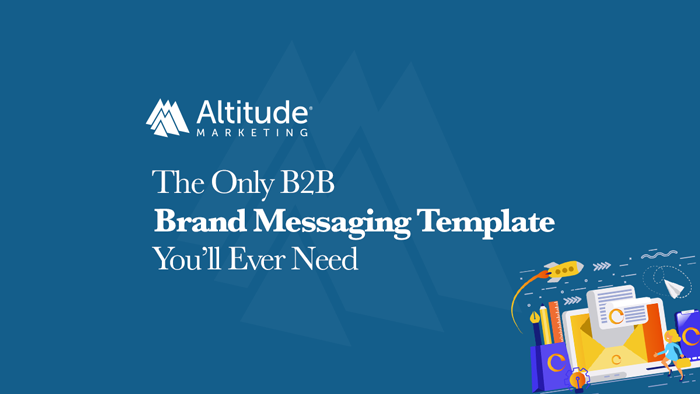Whether you’re building a new company or rebranding an existing one, defining your who and why is key. And it all starts with an effective B2B brand messaging template.
This is important whether you’re a marketer or not.
If you’re used to creating B2B brand messaging, a template keeps you on track and efficient. If you’re not, it makes the exercise possible.
First things first: To use this B2B brand messaging template, you need to get used to thinking about your company like a living breathing thing.
Think about the people in your life. You know what they’re like, and how they’re likely to respond. Creating messaging is doing exactly that for your company.
Just like with a human, it’s important that you don’t define yourself in a way that doesn’t match reality. It’s almost like an online dating profile. You want to keep things as honest as possible … and you’d hope the person on the other side of the screen does, too.
Admittedly, that’s a thought exercise. And it’s one that makes many business leaders think branding or rebranding is impossible. It can feel like an exercise that you don’t know how to start. You’ve probably even downloaded those premade templates that only ask you to fill in the blanks. The results can be … pretty generic.
Here’s the good news – we’ve got a five-step B2B brand messaging template that walks you through the process step-by-step. And here it is!

Step 1: Define Your Brand Personality
Different brands have different personalities. Some are bold. Some are compassionate. Some are the strong, silent type.
What’s yours?
In order to define your brand personality, you have to think about who you are as a team (and again, make sure it reflects reality).
If you are a big, boastful, sales-driven organization, you may not come across as quiet and confident. Conversely, if your processes are slow and thoughtful, you might not want to act oh-so big, bold, and brash.
Here’s the main takeaway: A human has a personality, and a brand has a personality. So when following this brand messaging template, make sure you know who you are as a company when defining your brand personality.
You’ll never publish your personality. Instead, you’ll use it to dictate how you say things. Your tone needs to match it, in all things.
Step 2: Figure Out Your Brand Attributes
That’s the how. What about the what? These are your brand attributes – the themes that weave their way through your brand.
Here’s a trick: Talk to company leaders, trusted clients and team members. Ask them one key question: What you do like about working with us?
There will be words that come up a lot. Use those. Those are your attributes! Your what!
Across the board, if they mention the service(s) you provide, your expertise, or your technical knowledge, make it a point to emphasize those things in your brand messaging. Be sure to let it happen organically, though. You can’t force this, and they can’t conflict with your personality.
Step 3: Ask Yourself: Why Us?
Ask yourself this: What do we do for our clients? I mean, they’re buying for a reason, right?
These are your differentiators.
What are their reasons and why would they choose us? The easy answer is usually “people, process and technology.” Sometimes that’s right. Sometimes. Everyone assumes that’s the reason. If that’s where you land, you need to give it a good, hard think.
When you’re adding differentiators to a B2B brand messaging template, you need to be saying things that your competitors can’t.
That’s what makes you special. That’s what makes you stand out. And that’s the stuff that’s innate to you.
Step 4: Tell a Story
Who doesn’t love a good story?
This doesn’t need to get into the nuts and bolts of an elevator pitch. It also doesn’t have to be as drawn out as the Twilight saga. This can be aspirational. This can be all of three words (if you really want it to be).
On an emotional level, describe your brand. Invoke something from your audience. Make them feel. Speak (or write, whatever) from the heart.
Again, this will probably never go external verbatim. But the brand story is the emotional heart of a branding or rebranding exercise. If you can’t articulate it – even if the language isn’t perfect – you don’t have a brand.
It could be a novel. It could be two sentences. Whatever it is, it needs to be you.
Step 5: Yes, You Still Need an Elevator Pitch
Elevator pitches are a big generic for a reason. You just need to have it as part of your brand messaging efforts.
You’ll have to give the elevator pitch whether you’re in an elevator or not. It should be short. We’re talking one-paragraph short. Pretty simple stuff. Easily digestible.
There should be a specific format for B2B elevator pitches. First, start with the problem: there’s an issue in the marketplace. Next, say: to solve X, we do Y, unlike Z.
(Nothing wrong with throwing some professional shade towards your competitors.)
What are you combining here?
Well, you’re writing according to your brand personality.
You’re emphasizing your themes and attributes.
And you’re highlighting your differentiators while telling a story.
See how it all comes together?
This is our brand messaging template for B2B companies who don’t know where to start. If you go through these five steps, you will have success with your messaging and branding exercise.



